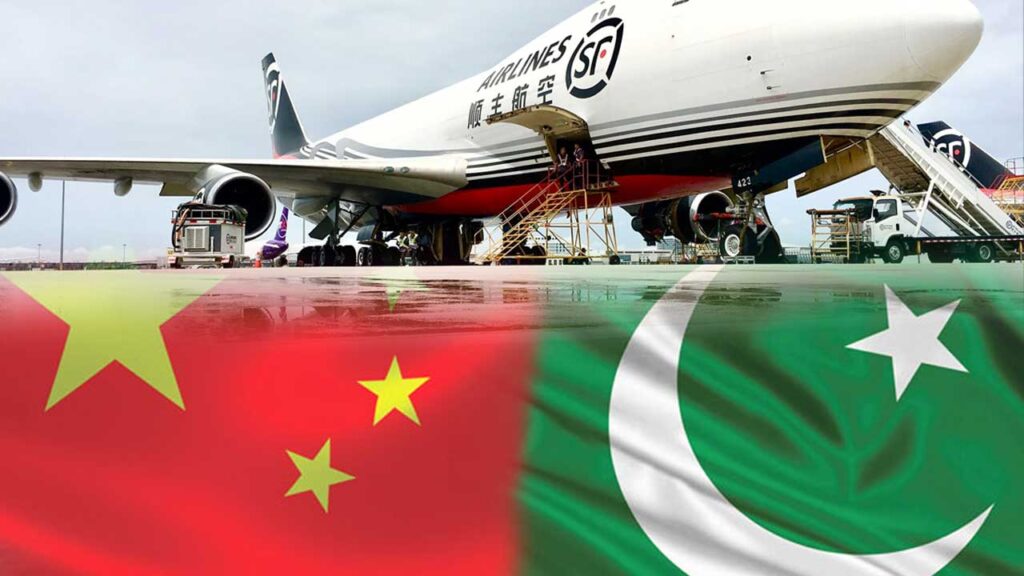How Pakistan-China Cargo Routes Are Reshaping Regional Trade
In an era where logistics, connectivity and cross-border commerce are transforming the global trade landscape, the evolving cargo routes between Pakistan and China are emerging as a pivotal axis of regional economic integration. With the dual goals of enhancing trade efficiency and reconfiguring supply‐chain geography, both countries are leveraging air, land, and sea corridors to shorten transit times, cut costs, and open new trade flows across South Asia, Central Asia, the Middle East and beyond. In this article we explore how these cargo routes are reshaping regional trade — the mechanisms, the opportunities, the challenges and the broader implications.
Strategic Background: The Pakistan-China Link
The foundation of the cargo route build‐out lies in the broader context of the China–Pakistan Economic Corridor (CPEC) and China’s Belt and Road Initiative (BRI). Pakistan sits at a strategic junction connecting China’s western province of Xinjiang Uygur Autonomous Region with the Arabian Sea. At the same time, China is keen to open alternative transit pathways to markets in South Asia, the Gulf and Europe.
For Pakistan, the payoff includes enhanced infrastructure investment, strengthened export potential, and positioning as a trade‐and‐transit hub. At the same time, China gains deeper access to maritime routes, inland access to South Asia, and a diversification of supply lines.
The emergence of multiple new cargo routes is more than incremental: it is reframing how goods move, where value is added, and which corridors matter for the next era of Eurasian trade.
Key Cargo Routes: Air, Land & Multimodal
Air Cargo
 Recent developments include the launch of direct air cargo connections between Chinese cities and Pakistani gateways. For example:
Recent developments include the launch of direct air cargo connections between Chinese cities and Pakistani gateways. For example:
- A route connecting Urumqi (Xinjiang) and Islamabad, inaugurated March 2025, doubling as a dedicated freight link operating twice weekly with around 26 tons capacity per trip.
- Other routes from Chinese cities such as Nanning to Karachi and Lahore, transporting Pakistani produce (fruit, seafood) to Chinese markets and Chinese inputs into Pakistan.
These air links are enabling high‐value goods, seasonal produce, e-commerce items and time‐sensitive cargo to move far more rapidly than by sea or road alone.
Land / Multimodal & TIR System
 Perhaps even more significant are the land and multimodal cargo corridors. A landmark example:
Perhaps even more significant are the land and multimodal cargo corridors. A landmark example:
- The launch of a corridor via the Khunjerab Pass through northern Pakistan linking Kashgar (China) to Karachi and onwards to the Gulf (UAE) in about 10 days, versus the conventional ~30 days sea route.
- The use of the TIR (Transports Internationaux Routiers) system at Pakistan’s dry ports (such as Sost in Gilgit-Baltistan) has reduced customs delays and enabled smoother transit across borders.
The quickening of transit time, enabled by land + sea linkages through Pakistan, is opening up new opportunities for Chinese exports/ re-exports and Pakistani exports to Gulf/Middle East via a more direct inland route.
Sea / Port Linkages
While much attention is on land/air, the role of Pakistani ports (e.g., the development of Gwadar Port, though not the main focus here) remains important for integrated multimodal trade. The idea is that cargo from China can travel overland into Pakistan and then ship onwards to markets in the Middle East/Africa, thereby bypassing longer maritime chokepoints.
Trade & Economic Impacts
Shorter Transit Times & Supply-Chain Efficiency
One of the headline benefits: dramatic cuts in transit times. The China-to-UAE route via Pakistan’s dry‐port + sea leg now reaches in ~10 days instead of ~30.Quicker routes mean fresher produce, fewer spoilage losses (particularly relevant for Pakistani agriculture headed for Chinese markets), and more responsive logistics. For example, Pakistani mangoes and other perishables stand to benefit from the Urumqi-Islamabad air route.
Growing Bilateral Trade and Regional Spill-Over
The air cargo route Urumqi-Islamabad saw the bilateral trade between Pakistan and China reach USD 23.06 billion in 2024—a year-on-year increase of ~11.1 %. This growth is evidence of how improved connectivity can stimulate trade volumes.
Moreover, the reconfigured flows have regional spill‐over effects:
- Pakistan increasingly positions itself as a transit hub for Chinese goods destined for South Asia, Central Asia, Middle East.
- Pakistani exports, especially fresh produce and textiles, gain improved access to Chinese internal markets and logistics networks.
- Enhanced connectivity helps integrate border regions (e.g., Gilgit-Baltistan, Xinjiang) that previously were less connected to global value chains.
Diversification of Routes and Risk Mitigation
These new cargo routes also diversify transit options and reduce reliance on traditional maritime chokepoints (e.g., Malacca Strait) or longer sea passages. For China, over-reliance on long sea routes is a strategic risk; for Pakistan, the opportunity is to be a linchpin in a broader logistics network.
Strategic & Geopolitical Implications
The cargo route expansion carries important strategic weight. The revamping of the Khunjerab corridor and make‐up of Pakistan as an overland gateway aligns with China’s aim to widen the footprint of the BRI beyond maritime-only routes. Regionally:
- Pakistan gains strategic significance as a trade corridor connecting China with the Middle East, Gulf and Africa.
- China strengthens its ties in South Asia and South-West Asia via logistics and commerce, not just infrastructure.
- The corridor also offers Central Asian states a potential alternative route via Pakistan, bypassing Afghanistan. For instance, the Quadrilateral Traffic in Transit Agreement (QTTA) has envisaged road links through Pakistan to Central Asia.
In sum, these cargo routes are not simply trade facilities—they are elements of strategic geography.
Challenges & Hurdles
Despite the clear promise, there are several challenges that must be managed:
- Infrastructure & Cold Chain: For perishables from Pakistan to reach China efficiently, cold-chain infrastructure and logistics must be upgraded. The Urumqi-Islamabad route audit noted Pakistan’s under-developed cold logistics leading to losses.
- Security & Stability: Routes through mountainous terrain (e.g., Khunjerab, Karakoram Highway) face climate, terrain and occasionally political/social disruptions. Blockades or protests along the corridor could disrupt flows.
- Customs, Regulatory and Institutional Hurdles: Even with systems like TIR, customs delays or inconsistent regulation can hamper the seamless flow of cargo. Ensuring inter-agency coordination, clearance procedures, and port/dry-port efficiency is critical.
- Scale & Volume: While new routes exist, scaling up to the volumes necessary to fully reshape regional trade will take time, investment and stable operations.
- Competitive Alternatives: Pakistan‐China corridors will face competition from other routes (e.g., Iran, Central Asia, Russia) and global logistics dynamics may shift based on cost, reliability and geopolitical factors.
What This Means for Pakistan: Opportunities & Imperatives
For Pakistan, the evolving cargo corridors open several opportunities:
- Export Diversification & Value Addition: With improved access to Chinese markets and faster logistics, Pakistan can ramp up fresh‐produce exports, textiles and manufactured goods.
- Transit Corridor Revenues: Pakistan can generate transit fees, logistics business, warehousing, dry‐port business and value from being a hub rather than just an end-market.
- Regional Hub Role: Pakistan can position itself as a logistics-platform country linking China, the Gulf, Central Asia and South Asia—a major leap from its historical role as primarily an importer/exporter.
- Job Creation & Regional Development: Especially in corridor regions (e.g., Gilgit-Baltistan, Balochistan, Sindh) the infrastructure build and logistics opportunities can spur local economies.
However, to fully leverage these, Pakistan must prioritize:
- Upgrading infrastructure (road, rail, dry‐ports, cold chain).
- Streamlining customs, regulations and clearance processes.
- Ensuring security, reliability and year-round operations of key passes (e.g., Khunjerab).
- Integrating domestic supply chains so Pakistani goods can feed into the corridors with the necessary quality and logistics readiness.
- Ensuring local trade communities, SMEs and regional stakeholders are integrated into the opportunity.
Broader Regional Trade Implications
The Pakistan-China cargo route developments are reshaping regional trade architecture in several ways:
- Shift in Trade Patterns: The region may see more north-south and westward flows (China → Pakistan → Gulf/Africa) as well as east–west flows (Pakistan → China), altering the historical sea-centric trade paths.
- Integration of Frontier Regions: Areas like Xinjiang in China, Gilgit-Baltistan in Pakistan, Central Asian states, may see greater connectivity to global value chains.
- Alternative Corridors for Global Trade: These routes provide alternatives to traditional maritime chokepoints and could relieve congestion, reduce transit times and diversify risk for global shippers.
- Competitive Pressure on Other Routes: As Pakistan’s corridors gain momentum, competing route providers (Iran, Central Asia, Russia) may accelerate their infrastructure, heightening competition and potentially lowering logistics costs region-wide.
- Geopolitical Leverage: Countries along the corridor gain strategic importance; trade connectivity becomes a tool of diplomacy, influence and regional alignment.
Outlook: What to Watch
Here are key indicators and developments to watch over the coming years:
- Volume Growth: How quickly trade volumes via these new routes grow, and how much of Pakistan’s export volume gets routed via air/land rather than traditional sea‐only routes.
- Expansion of Air & Land Links: Additional direct air‐cargo routes, increased frequency, and dedicated freight lanes – especially linking more Chinese manufacturing hubs with Pakistani gateways.
- Development of Dry Ports & Logistics Hubs: Upgrades at Sost, Islamabad, Karachi, Lahore dry-ports to support transits, warehousing, value addition and cold chain operations.
- Rail Integration: Progress on rail links (within CPEC/BRI framework) between Pakistan and China, reducing reliance solely on road/trucking.
- Regulatory / Customs Reforms: Implementation of streamlined clearance systems, digital customs, TIR expansions, and trade facilitation agreements.
- Security & Access Issues: Year-round access to key passes (Khunjerab, Karakoram Highway) despite seasonal/terrain obstacles; political stability in corridor regions.
- Regional Spill-over: How Pakistan leverages its corridor role to attract investment, build local supply chains, and diversify its trade base into Central Asia, Middle East, Africa.
Conclusion
The unfolding network of Pakistan-China cargo routes signals a fundamental shift in how connectivity and trade infrastructure are being configured across Eurasia. What once took weeks or months can now be compressed into days; coastal ports are being complemented – or bypassed – by overland corridors; frontier regions like Gilgit-Baltistan or Xinjiang are being plugged into global supply chains.
For Pakistan, the stakes are high: if managed well, the country can transition from being a periphery to becoming a pivotal logistics hub and export platform. For China, these corridors represent strategic diversification of trade links and deeper regional integration. For the broader region, the reshaping of cargo flows means that trade maps will not look the same in the coming decade.
However, the promise will be realized only if infrastructure, regulation, logistics systems and regional stability all keep pace. The next few years will determine whether these corridors become routine arteries of regional trade – or remain niche, symbolic pathways.
In short: we are witnessing not merely upgraded trade routes between Pakistan and China, but the emergence of a new logistics ecosystem that holds the potential to re-engineer regional trade flows. For businesses, governments and logistics operators alike, understanding and engaging with this transformation will be key to capturing the next wave of trade opportunity.








Leave a Reply